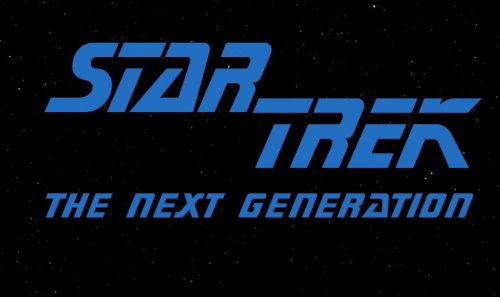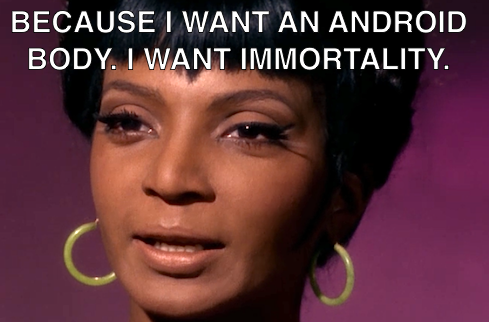 7:9 Force of Nature – This season’s recipient of the Preachy McPreacherson’s Preachiest Episode Award. In the Hekaras Corridor, an area of space where dense tetrion fields cause navigational problems, two scientists from an inhabited planet claim that warp fields — and thus all starship travel — damages the fabric of local space and endangers their planet. One of the scientists blow herself up in her ship, creating a spatial rift to prove her theories. Once the Enterprise gets free of the rift, they take her theories Very Seriously.
7:9 Force of Nature – This season’s recipient of the Preachy McPreacherson’s Preachiest Episode Award. In the Hekaras Corridor, an area of space where dense tetrion fields cause navigational problems, two scientists from an inhabited planet claim that warp fields — and thus all starship travel — damages the fabric of local space and endangers their planet. One of the scientists blow herself up in her ship, creating a spatial rift to prove her theories. Once the Enterprise gets free of the rift, they take her theories Very Seriously.
A lot of people say that it’s a bad environmentalist plot, but it’s actually a very good environmentalist plot, in that everyone — at least all the Good People Who Think Good Thoughts — assumes that therefore warp drive is damaging to all space everywhere, and that Starfleet’s resulting speed limit of Warp Five is obviously (to all Good People Who etc.) an inadequate response to a dire emergency. The truth, such as it is, is that no one has given any evidence that warp drive has any negative effect on the fabric of space anywhere without the pre-existing unique instabilities of the Hekaras Corridor… but everyone acts like, “Oh no! Warp drive is bad for all space everywhere! What’ll we do?!?!” That makes it a very good environmentalist plot (that is, good at portraying the “take no chances” overreaction that too many environmentalists have whenever their pet protection project is involved).
This episode is the reason why you hear occasionally in the later episodes that Starfleet is authorizing warp speeds in excess of their speed limits when a particular emergency hits.
7:10 Inheritance – Data gets a character episode! And Data discovers… he had a mother! Someone who worked closely with Noonian Soong in his formation, and was there during his initial learning ventures (which were pulled from his memory during an upgrade, and intended to be reimplanted, but then the Crystalline Entity attacked when he was offline, and…)
So she gets to tell everyone Data’s embarrassing baby stories and stuff, and then Data realizes that she’s an android herself — one in which human memories and thought patterns were implanted; she doesn’t know she’s an android, and the holographic message Data discovers from Soong in her positronic net asks Data to let her keep believing she’s human.
Man, we thought that the episode in which a handful of characters were age-regressed to puberty opened an un-dealt-with can of worms, in that it casually passed over them accidentally having discovered the Fountain of Youth through a simple transporter accident. Here, we reveal that technology exists/existed in Noonian Soong’s jungle planet hideaway where Data met him before he died, which could transfer one’s effective consciousness into an immortal android body. And no one in the crew even raises an eyebrow at it?

Also: This episode establishes that we’re actually supposed to notice Data ageing, as that’s a feature — not a bug! — of his android body. (But we’re then NOT supposed to notice it in the series finale, I guess.)
7:11 Parallels – Worf gets a character episode! Returning to the Enterprise on a shuttlecraft, Worf slowly notices both past and present events changing — first little things like the color of a birthday cake, later larger things like ranks, ship’s equipment, and marital statuses. He’s being shuffled around through quantum states, and experiencing every possible present!
(Let’s NOT deal with whether he’s displacing that reality’s Worf when he shifts; that would cause waaay too many ancillary concerns.)
Given that Data’s explanatory technobabble cites the idea that every possible decision point results in the multiplication of quantum realities, I would have liked to see this written as Worf moving between realities which resulted from his own decisions — one where he was still paraplegic, or where he never came back to Starfleet after resigning his commission, etc. But then the challenge would have been not to make it yet another iteration of It’s a Wonderful Life (especially when Picard just had one of those the previous season).
This episode is especially notable for beginning the teasing subplot of a Worf/Deanna relationship that’s toyed with in several episodes this season.
(My favorite un-remarked-on quantum change? In one reality, Data’s eyes are sky blue.)
Exactly: as with the Preachy McPreacherson episode “Outcast” from season 5, the episode ends up inadvertently teaching a very different lesson from the one its writers (or Gene Roddenberry himself, anyway) probably intended by leaving some of us saying “Uh, it looks to me like the ‘bad guys’ here are right.”
Yeah, it’s another one of those episodes that would have made the whole plot of Star Trek: Insurrection completely unnecessary… if it didn’t also bring up the old when-you’re-transported-is-that-really-you-or-just-a-copy-of-you can of worms the same way that “Second Chances” episode back in season 6 inadvertently did. When it comes to “transferring consciousness” in order to get a fountain of youth, I’d sooner take my chances with “regenerative transportation” into a younger version of my own body as discovered in that “Rascals” episode than risk being replaced and deleted; the Star Trek franchise writers at least occasionally hand-wave that whole question about the transporter by saying it uses a “matter stream” which truly transfers your consciousness rather than replacing and deleting you like a computer file being transferred between hard drives.
Here again, as with many other episodes, it also (probably) would have cost too much money to make it that way. That’s one advantage books still have over television and movies: they operate with an essentially unlimited budget.